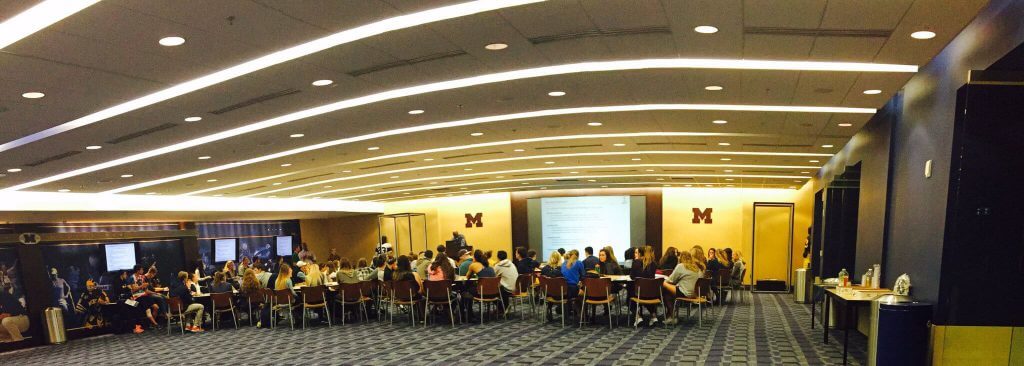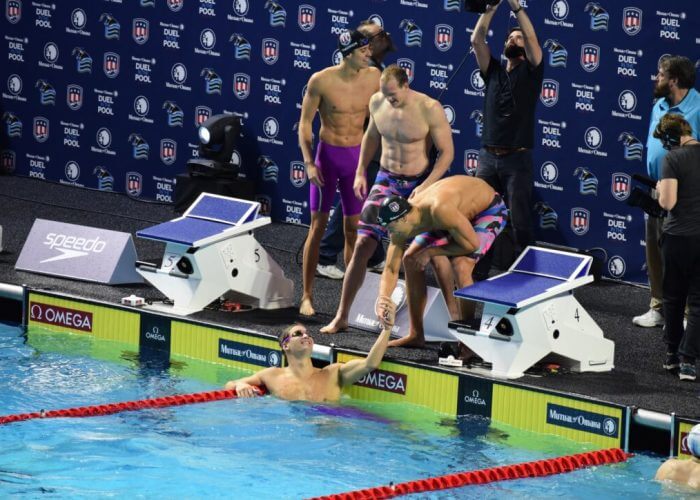5 Reasons to Get Involved in Your Campus SAAC

By Katie Wingert, Swimming World College Intern.
Upon first glance, the Student-Athlete Advisory Committee (SAAC), a student-athlete organization required by the NCAA on every campus in the country, might sound like a mere boring mandate. In reality, though, SAAC can enrich many athletes’ lives—including those of swimmers.
On every NCAA campus, a select group of student-athlete representatives from each team meet multiple times each semester to connect as a community, vote on pending NCAA policies, and discuss campus events and initiatives that directly relate to student-athletes. Each campus-level committee is in turn represented by one or more athlete representatives at the conference level, and each conference-level committee is then represented at the divisional level by one or more conference representatives. These seemingly stringent requirements ultimately offer swimmers an immense range of opportunities.
Here are 5 reasons why college swimmers should get engaged in their campus SAAC:
1. SAAC allows swimmers to get to know other student-athletes on campus.

Photo Courtesy: @salto_coach Twitter
As swimmers, the reality of our sport is that we spend a lot of time with one another in an aquatic environment, but we interact a lot less with other sports teams than all of the land-loving student-athletes on campus. We are much less likely to split field time, track time, and locker room time with these land-lovers, and, as a result, we are much less likely to spend time with them. Getting involved with a campus SAAC allows swimmers to break out of their infamous chlorine bubble and get to know their fellow student-athletes.
2. SAAC allows swimmers to find more fans for meets.

Photo Courtesy: Taylor Brien
Another reality of being a swimmer is that our meets are long, boring, and often not well-attended. College students have plenty of things to do on the weekends, and waking up early to sit on a humid pool deck for four hours is not usually at the top of their agenda. But by making connections in SAAC with other student-athletes—who know what it feels like to perform for empty bleachers—swimmers can garner a few extra fans in the stands. SAAC often promotes brother-sister team relationships and sport event announcements, which give teams the opportunity to pack the stands for big competitions—like that big Tuesday night dual meet that no one ever attends but the parents.
3. SAAC allows swimmers to earn a voice in important conversations with both campus administration and with the NCAA.

Photo Courtesy: Cathleen Pruden
SAAC is often the communication bridge between university administration and the general student-athlete body, so by being involved with the committee, swimmers can stay abreast of information and even voice opinions about different campus concerns. For example, SAAC can be the setting for working out weight room scheduling issues, questioning pending facility remodels, and discussing fundraising questions from teams. Additionally, because committees serve as official liaisons between individual teams and the NCAA, swimmers participating in SAAC have the opportunity to vote on upcoming NCAA legislation and initiatives, like scholarship rules, recruiting policies, and drug and alcohol education initiatives. These opportunities allow swimmers to be more than passive complainers; rather, they can be active participants in the future of intercollegiate athletics.
4. SAAC allows swimmers to become better leaders.

Photo Courtesy: Annie Grevers
By interacting with other student-athlete leaders and participating in an official organization, swimmers can develop leadership skills to carry into both their current roles within their teams as well as their future roles in the professional world. The committee allows student-athletes to discuss the ways that different teams handle controversies and foster community on their team, including effective methods of communication and helpful conflict resolution methods. SAAC models these techniques as well through challenging, productive conversations on issues and policies within athletics that student-athletes need to consider on a daily basis, including Title IX.
5. SAAC allows swimmers to get involved in meaningful events and activities happening on campus.

Photo Courtesy: Tara Freeman
College campuses always have something going on, and the jam-packed calendars can be overwhelming to consider, given the already crowded schedule of the average swimmer. However, SAAC helps athletes become more aware of programming that is meaningful to athletes and their greater community. For example, many campus committees organize service projects, like an elementary school sports day, a canned foods drive, a polar plunge charitable fundraiser, and more. Additionally, SAAC often hosts social events—like an all-athlete picnic or March Madness viewing party—that can be fun and community-building.
SAAC certainly isn’t for every swimmer—usually, representatives are nominated by coaches or student-athletes—but those swimmers who do have the opportunity to get involved should jump on it. The commitment is generally small, but the benefits are big.
All commentaries are the opinion of the author and do not necessarily reflect the views of Swimming World Magazine nor its staff.



